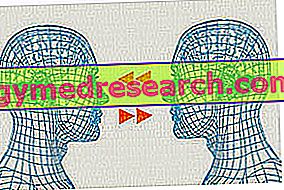Related articles: Neuroblastoma
Definition
Neuroblastoma is a malignant tumor characteristic of the pediatric age. This neoplasm derives from neural crest cells, from which - during the formation and development of the embryo - the medullary of the adrenal (endocrine gland placed above the kidney) and the ganglia (physiological group of cells present along the course of a nerve) of the sympathetic nervous system.
Neuroblastoma can occur at abdominal level (in about 65% of cases), thoracic (15-20%), in the neck, in the pelvis or in other locations; rarely, however, this can manifest itself as a primary tumor of the central nervous system.
The underlying causes of neuroblastoma are not yet certain. Cytogenetic abnormalities (including N-MYC rearrangements, mutations or amplifications) and the intake of certain substances by the mother during pregnancy (eg alcohol, hydantoin and phenobarbital) may contribute to the onset of the disease.
The age of onset typical of neuroblastoma is early infancy: about three-quarters of cases occur in children under the age of 4 years.
Most common symptoms and signs *
- Anemia
- Anorexia
- Asthenia
- Ataxia
- Muscular atrophy and paralysis
- Intermittent claudication
- Dyspnoea
- Abdominal distention
- Chest pain
- Bone pain
- Hepatomegaly
- Exophthalmos
- Ease of bleeding and bruising
- Temperature
- Abdominal swelling
- Hypertension
- Abdominal mass
- Mass or swelling in the neck
- myoclonus
- Nystagmus
- Black eye
- Pallor
- Loss of coordination of movements
- Weight loss
- petechiae
- thrombocytopenia
- Muscle spasms
- Sweating
- Tachycardia
- Cough
Further indications
The symptomatology is extremely varied and depends on the site of the primary tumor and the mode of spreading the disease. The most frequent manifestations are fever, asthenia, irritability, weight loss, abdominal bloating and bone pain. In the case of a neuroblastoma with intrathoracic localization, the appearance of cough and difficulty in breathing can be observed. When the tumor originates in the lower portion of the abdomen, instead, there will be bladder and / or intestinal disorders, like recurrent pain in the abdomen, associated with loss of appetite, distension and sense of fullness for the compression of the viscera. Furthermore, sometimes children have focal neurological deficits or paralysis due to the direct extension of the tumor into the medullary canal.
Most neuroblastomas produce catecholamines, which can be detected by raising the levels of their catabolism products in urine. This can result in a paraneoplastic syndrome manifested by constant diarrhea, high blood pressure, rapid heart rate and sweating.
Some symptoms can be caused by metastases, which generally occur in the bone marrow, liver, bones, lymph nodes, or, less commonly, skin and brain. These manifestations may include claudication, hepatomegaly, exophthalmos, bilateral periorbital hematomas, frequent infections and altered general health status.
At the time of diagnosis, approximately 40-50% of children have localized or regional disease, while 50-60% have metastases. Localized forms can be discovered causally or revealed by the presence of an abdominal or thoracic mass, which can be associated with pain. In any case, neuroblastoma is associated with an increase in the levels of urinary catecholamine metabolites and can be identified initially through ultrasound, brain exploration or MRI. Complementary investigations such as biopsy and scintigraphy are useful in identifying the stage and metastasis of the tumor.
Localized forms of neuroblastoma can be treated with surgical resection and conventional chemotherapy. If metastases are present, however, the therapeutic approach may include the initial removal of the tumor, high-dose chemotherapy associated with hematopoietic stem cell transplantation and local radiotherapy. In general, children younger than one year have a better prognosis than older patients.


